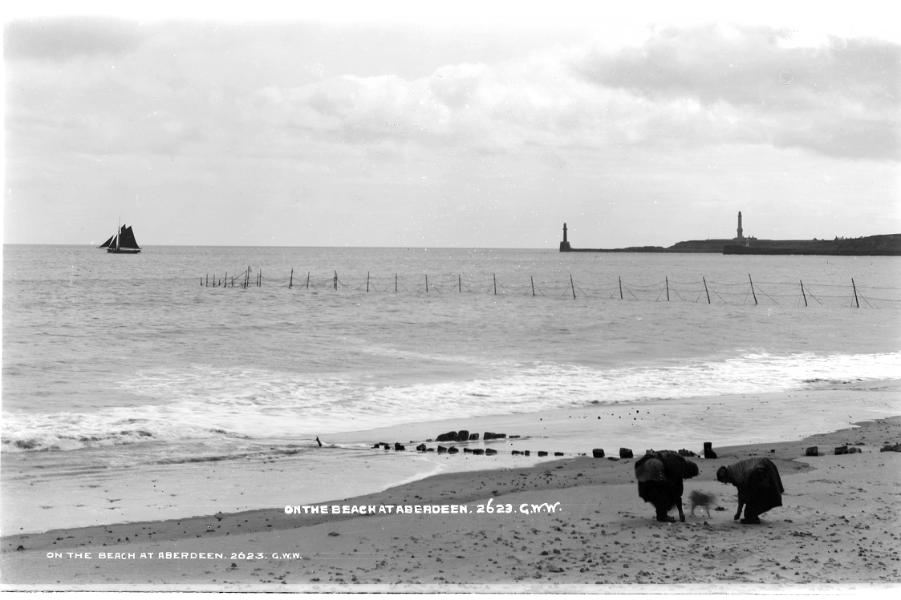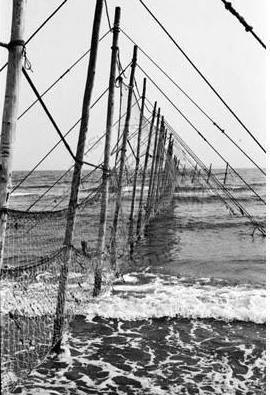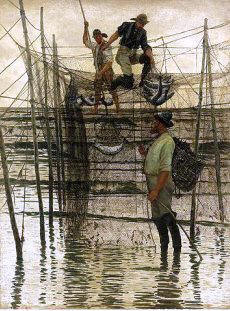Salmon Bag Nets
Standing Salmon Rag Nets – Fixed Engines, Stake Nets or Bag Nets
The Bag net is an intricate system of Nets, Staked to the Sea Bed that blocks the path of Migrating Salmon and funnels them into a Holding Net, from where the Netsmen haul them out. One end is anchored to the Low Water Mark the other Stakes are set at Sea. Fishing for or taking Salmon by Bag Net, Fly Net or other Stake Net means the use of a Fish Trap (including the use of a Landing Net to remove Salmon from such a Trap) consisting of one or more Fish Court & associated Inscales & Wings, together with a Leader Net designed to lead the Salmon into the Trap; the whole of which is fixed or moored to the Shore or Seabed; provided that:
- no part of the Bag Net, Fly Net or other Stake Net except Mooring Warps & Anchors shall extend Seawards beyond 1300M from the mean Low Water mark
- no part of the Net or Trap is designed or constructed for the purpose of catching Fish by enmeshing them
- The Regulations also state that “No monofilament netting shall be used in the construction of any Net used in Fishing for or taking Salmon.“, and “Any Net used in Fishing for or taking Salmon shall have a mesh size of not less than 90mm”
With Season Lasting from February until September it was Gruelling Work, the Netsmen out in all Weathers
The Fixed Engine is an archaic term to describe the Rag Nets used since the early 1800s to catch Salmon on the Coast outside Estuary Limits. The 2-Types still in general use are Bag & Stake Nets; the latter include Fly & Jumper Nets. All these Nets rely on a behavioural characteristic of Salmon, whereby they will lead along a Netting Barrier rather than attempt to swim through it. Bag & Stake Nets consist of 2-Pitches Seaward at right-angles to the Shore to the centre of the 3 Chambered Arrow shaped Trap. Some of the Salmon that swim along the Leader may end up in the Trap. Bag Nets are usually fished along Rocky Shores where they are held in position by floated Lines & Anchors. They are Fished from a Flat Bottomed Boat (Coble) Crewed by 3-5 persons. Stake Nets which include Fly & Jumper Nets are Fished on Sandy Beaches or Mudflats where the Stakes used to support the Netting are set into the soft Substrate. After Erection, they are Fished by 1-man. Stake Nets operate like Funnel Traps into which Salmon swam and could not escape.
The Function & Structure of the Bag Nets. The diagram above shows that Bag Nets are very large & heavy structures over 100-yards long and about 16-ft high. In addition, the Bag Net portion with its 3-Chambers would be about 50-60-ft in length. The Leaders for Bag Nets had to be set out each week during the Salmon Fishing Season. This was due to the local culture which demanded that no Fishing could take place on a Sunday, and latterly the Law also set out Statutory Rules on which days Fishing could take place and on which days Fishing was prohibited. Thus the Leader Nets had to be Lifted & Laid on a regular basis. The Bag Nets were secured to the Seabed with heavy Anchors.
The Bag Nets & Leader were run out at right angles to the Coast-line and typically the Salmon, entering Aberdeen Bay, for example, would swim diagonally towards the Shore as they sought the ‘scent’ of the River they were trying to get back to. This behaviour would inevitably lead them into the Path of the Leader of one of the Bag Nets thus causing them to turn & swim away from the Shore along the Leader with the result that they would enter the Bag Net system at the end of that Leader. As you will see in Diagram there were 3-Bag Nets, the Cleek, the Doubling, & the Fish Court.
The Entrance to each gets progressively smaller, the final entry being only a 6-ins wide opening through which the Salmon entered the ‘Fish Court’ from which they did not usually escape. Typically, once in the Fish Court, the Salmon would swim around that Chamber by following the Path of the Nets and so would miss the small 6-inch opening in the Angled Wings of the Fish Court. Although not clear in the above Diagram the Bag Nets were also Netted top & bottom so that they were completely enclosed apart from the Openings which enable the Fish to enter the Bags. Occasionally a Fish would escape through the small 6-in opening, and often, when the other Fish saw how it was done, they would all follow suit and the Catch would be gone! There were ‘Doors‘ in the Fish Court through which, when opened, the Fish Catch could be retrieved.
A lone Fisher returning with his Catch after waiting for the Tide to Ebb sufficiently to allow him to enter the Chamber at the Seaward end of the Jumper Net and remove the Fish caught using a Hand Net, commonly called a ‘Scum’.

This Picture shows the Scale of the Bag Nets as they Stretch out over the Strand from the Low Water Mark to Deep Water.
1830 – Layout of Rag Nets on the Don Estuary
Haaf & Poke nets are unique to the Solway Firth. Haaf Nets are large hand-held Nets which were brought to the Solway by the Vikings. Poke Nets are net Pockets held up on Poles and arranged in Lines set across the Tide. There is strong community support to preserve these ancient traditional methods of Fishing, not only for the sake of our Cultural Heritage, but also because the Revenues raised by the Sale of Licences in the Annan Fishery District, for example, contribute to the Common Good Fund.



